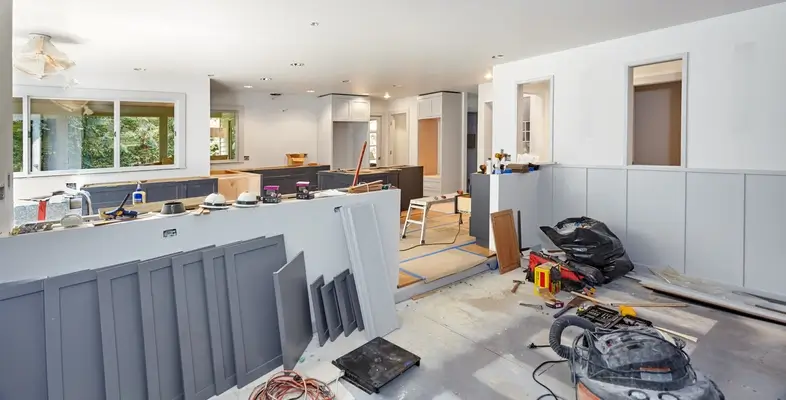If you’re a veteran dreaming of homeownership but feel overwhelmed by the thought of buying a property that needs repairs, there’s a specialized VA program designed just for you.
The VA renovation loan combines the best features of a typical VA loan—zero down payment, no private mortgage insurance, and competitive interest rates—with the ability to finance home repairs or upgrades.
This guide will walk you step by step through how it all works, why it benefits veterans specifically, and what to expect as you move forward.
What Is a VA Renovation Loan?
A VA renovation loan, or often referred to as a VA rehab loan lets eligible veterans purchase a home and fund renovations in a single mortgage.
This means you can roll the cost of repairs—like fixing a leaky roof, updating your kitchen, or replacing outdated wiring—into your total loan amount, up to your 2025 VA entitlement limit of $806,500 (depending on your available entitlement and lender caps). You still enjoy all the core benefits of a VA loan, including zero down payment and no monthly PMI.
For many service members, the search for a home that’s “move-in ready” can be challenging. Sometimes, you’ll come across a property with solid potential but is a fixer-upper need of some TLC—maybe it has an older roof, outdated electrical systems, or a kitchen stuck in the 1980s.
With a VA renovation loan, you don’t have to walk away from these opportunities. Instead, you can bundle the purchase price and repair costs into one mortgage.
- Convenient Financing: No juggling separate loans or paying out-of-pocket for costly repairs.
- Full VA Benefits: Zero down payment, no PMI, and competitive rates.
- One Closing: Pay less in closing costs and streamline your paperwork.
These unique features make the VA renovation loan a powerful tool for veteran homebuyers who want to create a home that meets their exact needs. Whether you’re a newly separated service member or a long-time veteran, this loan can help you turn a fixer-upper into the perfect space for you and your family.
Why Consider a VA Renovation Loan?
A VA renovation loan is ideal if you’ve found a home with good bones but in need of repairs or upgrades. Instead of paying for both a mortgage and separate repair bills, you get one loan that covers everything.
You save on out-of-pocket costs, keep your monthly payments manageable, and can tap into potential home equity growth once the renovations are complete.
The VA renovation loan exists to give veterans extra flexibility. Regular VA loans have something called Minimum Property Requirements (MPRs). If the house you’re eyeing doesn’t meet these standards—like having a safe roof or reliable heating system—it generally won’t pass the VA appraisal process without repairs. That’s where a VA renovation loan shines.
- Works Within Your Entitlement: In 2025, the full VA loan entitlement can go up to $806,500, giving you plenty of room for both the purchase price and renovation costs.
- Fix MPR Issues: Instead of dropping the deal because of a bad roof or faulty plumbing, this loan allocates the funds you need to address those problems.
- Long-Term Value: By upgrading a home in a rising market, you can quickly build equity. Real estate experts, such as Redfin, predict a 5% annual growth in home values for 2025, which could accelerate your home’s value after the upgrades are done.
- Lower Monthly Payment: VA interest rates are often lower than conventional loans. Pair that with no monthly PMI, and you could see significant savings compared to a standard mortgage. For instance, on a $300,000 home at 5.5%, your monthly payment could be about $1,400—a lower amount than you’d typically pay on a conventional loan at 7% with PMI.
This option isn’t just about saving money. It’s also about having the freedom to pick a property you truly love—even if it needs some work—and making it your own.
How Is a VA Renovation Loan Different from a Standard VA Loan?
A standard VA loan covers homes that already meet VA minimum property requirements, while a VA renovation loan includes financing for significant repairs or updates.
Both loan types let you put zero down and skip PMI, but the renovation loan requires you to work with VA-approved contractors, deal with a longer closing time (60-90 days), and submit a repair plan before final approval.
While both standard VA loans and VA renovation loans share the same fundamental benefits—like zero down payment and no PMI—the renovation version is specifically designed to tackle homes that need more than simple cosmetic touch-ups.
For example, if you want a turnkey property that already meets all the VA’s MPRs, a normal VA loan works great. But if the property needs a new roof, a new HVAC system, or any structural repairs that would otherwise disqualify it under standard VA guidelines, the renovation loan option allows you to finance those repairs upfront.
| Feature | VA Renovation | Standard VA | Why It Matters |
|---|---|---|---|
| Loan Cap | Up to $806,500 (2025) | Up to $806,500 | Both can go high, but reno includes repairs |
| Repairs | Funds major repairs | Minimal repairs allowed | Renovation covers bigger projects |
| Interest Rate | Competitive VA rate (e.g., 5.5%) | Competitive VA rate (e.g., 5.5%) | No added rate penalty for reno |
| Timeline | 60-90 days | 30-45 days | Longer due to contractor bids and appraisals |
| Lenders | Fewer offer VA reno | Widely available | Might need to shop around more |
This table highlights why a VA renovation loan is better suited for fixer-uppers while a standard VA loan is perfect for move-in-ready homes.
What Can You Fix with a VA Renovation Loan?
You can fix almost anything that improves the home’s safety, structural integrity, and livability, including roofs, foundations, HVAC systems, plumbing, electrical, kitchens, and bathrooms. Cosmetic upgrades like painting or new flooring also qualify, but bigger jobs (such as structural and safety fixes) often provide the most value.
The range of allowable repairs with a VA renovation loan is broad, so long as those repairs help the home meet (or continue to meet) the VA’s Minimum Property Requirements. You can typically finance:
- Structural Repairs: Roof replacements, foundation fixes, and wall reinforcements.
- System Upgrades: HVAC overhauls, plumbing updates, and electrical rewiring.
- Safety Improvements: Removing mold, fixing termite damage, or resolving water leaks.
- General Renovations: Kitchen remodels, bathroom upgrades, and new flooring.
- Cosmetic Enhancements: Painting, landscaping, or minor aesthetic touches.
If you’re purchasing a $300,000 home that needs a $50,000 roof replacement and a new kitchen, you can request a VA renovation loan of $350,000 to cover both the home purchase and the repairs. The key requirement is to use VA-approved contractors—the VA wants to ensure qualified professionals handle the work.
How Do You Get a VA Renovation Loan?
First, find a lender that offers VA renovation loans. Next, select a property needing repairs, gather contractor bids, and complete the VA-required appraisal. Once approved, you close on the loan, and the lender pays contractors as work is completed. The whole process can take about 60-90 days from start to finish.
Below is a simple step-by-step walkthrough to help veteran homebuyers navigate the VA renovation loan process. Imagine you’re buying a $280,000 home that needs $50,000 in repairs for a total loan of $330,000.
- Find a VA Lender Offering Reno Loans: Not all VA lenders handle these specialized loans. Start by contacting lenders like Veterans United, Navy Federal Credit Union, or others known for veteran-focused financing. Don’t be discouraged if the first lender says no—some lenders simply don’t offer renovation programs.
- Select a Fixer-Upper: Ensure the property you pick can realistically be brought up to VA standards. Total gut jobs can be tricky, but major repairs and upgrades are typically allowed.
- Get Contractor Bids: Gather at least two detailed bids from VA-approved contractors. Each bid should clearly break down the costs for labor and materials. If your total repair estimate is $50,000, your lender will review these bids to confirm feasibility.
- Go Through the VA Appraisal: A VA-approved appraiser will estimate the property’s “as-completed” value. This value is crucial, as it affects how much you can borrow. The appraisal fee ranges from $500-$700.
- Close on the Loan: Once the appraisal is done and your bids are approved, you’ll finalize the mortgage. You’ll sign documents that combine the home purchase ($280,000) and repair costs ($50,000) into one loan.
- Renovation and Payout: After closing, the lender disburses funds to the contractors as the work progresses. You’ll typically have an agreed-upon timeline (60-90 days) to complete the renovations.
Keep in mind the process usually takes longer than a traditional VA loan—plan for 60 to 90 days before you can move in. Patience is key, but the end result can be well worth the wait.
| Item | Cost Range | Notes |
|---|---|---|
| Purchase Price | $200K-$600K | Must fit within your \$806K entitlement |
| Repairs | $10K-$100K+ | Includes structural and cosmetic |
| VA Funding Fee | Approx. 2.15% of loan | Could be waived if you have a service-connected disability |
| Closing Costs | $6K-$12K | Lender fees, title, etc. |
| Appraisal | $500-$700 | Appraiser values the home “after” renovations |
Why Is a VA Renovation Loan a Smart Move in 2025?
With interest rates around 5.5% and property values projected to grow by roughly 5% in 2025 (according to Redfin), a VA renovation loan can help you gain equity fast. You finance everything up front at a lower rate with no PMI, which often results in more affordable monthly payments and quicker equity growth once the repairs are done.
Why It’s a Smart Move in 2025
Experts like Redfin predict a 5% annual increase in home values for 2025, meaning your investment in a fixer-upper could appreciate rapidly once renovations are finished. Couple this potential price growth with the fact that 43% of veterans already use VA loans (according to the U.S. Department of Veterans Affairs), and it’s clear these loans are a staple in the veteran community for a good reason.
- Lock in a Lower Rate: Current VA rates—let’s estimate around 5.5%—are competitive. If conventional rates sit at 7% or higher, that difference can add up to substantial monthly savings.
- Zero Down Payment: You can finance 100% of the home and renovation costs up to your entitlement cap without needing thousands of dollars in upfront cash.
- No PMI: Conventional loans often require private mortgage insurance if you put down less than 20%. Skipping PMI can reduce your monthly bill by hundreds of dollars.
- Built-In Equity: By purchasing a property for $300,000, investing $50,000 in upgrades, and watching the home value climb to $385,000, you’ve created at least $35,000 in equity right away.
What Challenges Might You Face?
Expect a longer closing timeline, difficulty finding a lender that offers VA renovation loans, and the need for VA-approved contractors. Also, if you’ve already used part of your VA entitlement, you’ll have a reduced limit. Lastly, contractor or inspection delays can push back your move-in date.
Challenges You Might Face
While the VA renovation loan can be your ticket to a dream home, it’s not always smooth sailing. Here are some common stumbling blocks:
- Lender Availability: Fewer lenders offer VA renovation loans compared to standard VA loans. You may have to contact multiple lenders before finding a good match.
- Longer Closing Time: Typically 60-90 days due to extra paperwork, contractor bids, and the “as-completed” appraisal.
- VA-Approved Contractors Required: You can’t just hire any handyman. The contractor must meet specific criteria. This can limit your options and sometimes cause delays.
- Partial Entitlement: If you used some of your VA entitlement on a previous home, you might not have the full $806,500 available. This can reduce how much you can borrow.
- Possibility of Contractor Delays: Renovations don’t always go as planned. A single missed deadline or inspection issue can extend your timeline.
Real Stories of VA Renovation Wins
Countless veterans have turned neglected properties into valuable homes using VA renovation loans. For instance, one veteran purchased a $280,000 “fixer” and invested $40,000 in upgrades—resulting in a property worth $350,000 after just 75 days. Another replaced an outdated HVAC system and tackled a full kitchen remodel, closing the loan in under 90 days.
Real Stories of VA Renovation Wins
Veterans nationwide have used these loans to transform rough-around-the-edges properties into comfortable, modern homes. Here are some real-life examples:
- $280K Purchase, $40K Repairs: A veteran bought a dated bungalow for $280,000. They used $40,000 to replace the leaky roof and remodel the kitchen. After 75 days, the home was appraised at $350,000.
- $300K Reno, $50K Total Overhaul: Another veteran tackled a larger project, gutting most of the interior. Though the process took close to 90 days, the final product was a dream home, valued well above the combined purchase and renovation costs.
- $260K with a $20K HVAC Fix: Sometimes renovations aren’t flashy. Fixing an old HVAC system was enough to meet the VA’s MPRs. The process hit a few contractor snags but still closed successfully.
- $320K Purchase, $30K Upgrades: This veteran did a simpler remodel focusing on the bathrooms and flooring, ultimately building tens of thousands of dollars in equity in just a few months.
These stories highlight how a VA renovation loan can rapidly boost your home’s value and give you the freedom to create a living space that meets your tastes and needs.
Why Does It Beat the Alternatives?
VA loans generally require zero down payment and no PMI, which means lower monthly costs compared to conventional or FHA 203(k) renovation loans. Plus, the VA entitlement limit (up to $806,500 in 2025) gives you significant buying power and flexibility to fund extensive repairs.
Why It Beats the Alternatives
You may be aware of other options like FHA 203(k) loans or conventional mortgages for purchasing fixer-uppers. However, for most eligible veterans, the VA renovation loan usually stands out:
- Zero Down vs. 3.5% or 5% Down: FHA 203(k) loans require at least 3.5% down, while conventional loans typically need 5% to 20%. VA loans require no down payment.
- No PMI vs. Mandatory Mortgage Insurance: Both FHA and many conventional loans add monthly mortgage insurance unless you have 20% equity, which increases your monthly payment.
- Higher Loan Limits vs. FHA Caps: FHA 203(k) loans often have lower county-based limits. Meanwhile, the VA’s 2025 entitlement limit is up to $800,500, accommodating more expensive markets.
- Competitive Rates vs. Potentially Higher Rates: Conventional renovation loans can have slightly higher interest rates. VA rates are often among the most favorable on the market.
When you combine the benefit of no PMI, a potentially lower interest rate, and 100% financing, it’s easy to see why so many veteran homebuyers opt for a VA renovation loan instead of other programs.
FAQs About VA Renovation Loans
What’s a VA renovation loan?
It’s a specialized version of the standard VA home loan that lets you finance both the purchase of a home and the cost of repairs or upgrades in one mortgage. This is especially helpful if the home doesn’t meet VA’s minimum property requirements or simply needs a facelift.
How much can I borrow with a VA renovation loan?
The maximum generally goes up to your full VA loan entitlement, which is capped at \$806,000 in 2025 for many markets (though some high-cost areas may differ). Your lender will also consider your income, credit, and the property’s “as-completed” appraised value to determine the exact loan amount.
What repairs qualify for a VA renovation loan?
You can fix most issues that affect the safety, structural integrity, or livability of the home. Common examples include roof replacement, HVAC upgrades, plumbing and electrical work, kitchen renovations, bathroom overhauls, and even basic cosmetic improvements like painting.
How long does a VA renovation loan take?
It typically takes anywhere from 60 to 90 days. The process involves more steps than a standard VA loan, including contractor bids and an appraisal based on the future condition of the property.
Can I use partial entitlement for a VA renovation loan?
Yes, but your available loan limit might be lower. If you already used part of your VA entitlement on another home, you’ll need to calculate how much remains. This could impact the total amount you can borrow for your renovation project.
Do all VA lenders offer renovation loans?
No. You’ll likely need to shop around to find a lender experienced with VA renovation loans. Don’t be discouraged if you get turned down by one or two places—some lenders simply choose not to offer this type of financing.
What’s the difference between VA reno and standard VA?
Both loans share the same core VA benefits—zero down payment, no PMI, competitive interest rates—but only a VA renovation loan allows you to finance significant repairs or renovations. A standard VA loan requires the home to meet VA minimum property requirements at purchase.
Can I do DIY repairs with a VA renovation loan?
Generally, no. The VA requires licensed, VA-approved contractors to complete the work. This ensures quality and helps protect both you and the lender’s investment.
How does the VA pay for renovations?
The total loan amount combines your home purchase and estimated renovation costs. As work is completed, your lender disburses funds to the contractors. You won’t handle direct payments, which streamlines the process and ensures work is done correctly.
Is a VA renovation loan worth it?
If you’re a veteran looking to personalize a home or snag a property that needs upgrades, the answer is often yes. You get to roll the cost of major improvements into one mortgage, enjoy a competitive VA rate, skip monthly PMI, and potentially build instant equity once the upgrades are finished.
Next Steps for Veteran Homebuyers
For veterans ready to begin their journey, here’s what you can do next:
- Check Your VA Entitlement: Make sure you know how much of your benefit is still available. Visit the official VA website or speak with a VA-approved lender.
- Get Pre-Approved: Ask your chosen lender for a pre-approval, specifically for a VA renovation loan.
- Start House Hunting: Look for properties with potential that need repairs but aren’t complete teardowns.
- Gather Contractor Bids: Contact multiple VA-approved contractors for accurate project quotes.
- Stay Organized: Keep all paperwork (bids, appraisals, approval letters) in one place to simplify the closing process.
With the right planning and a patient approach, the VA renovation loan can turn even the most daunting fixer-upper into a comfortable family home while maximizing the unique benefits your military service has earned you.
For more insights on VA loans, tips for finding trustworthy contractors, and updates on other veteran-specific programs, be sure to explore our VA Loan and Renovation Resource Center. You can also consult reputable organizations like the VFW and your local state veteran affairs office for additional support.
















